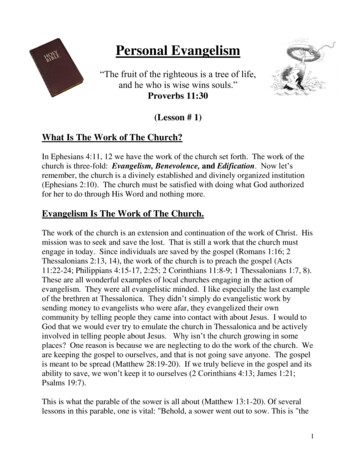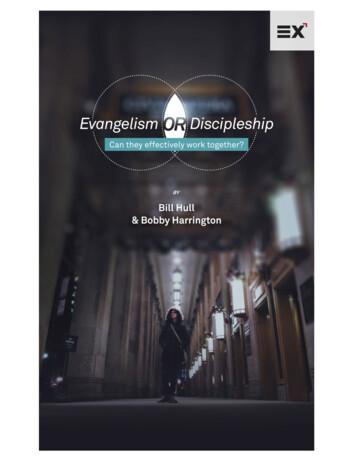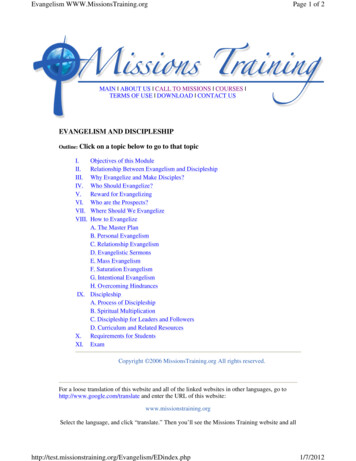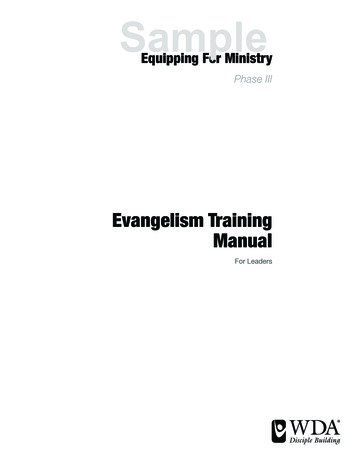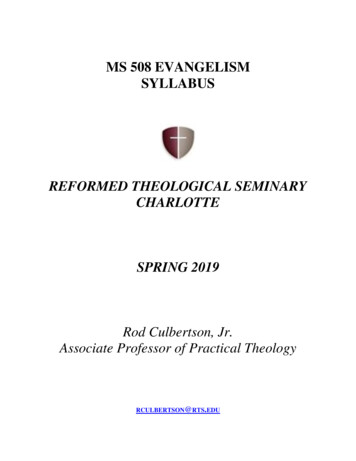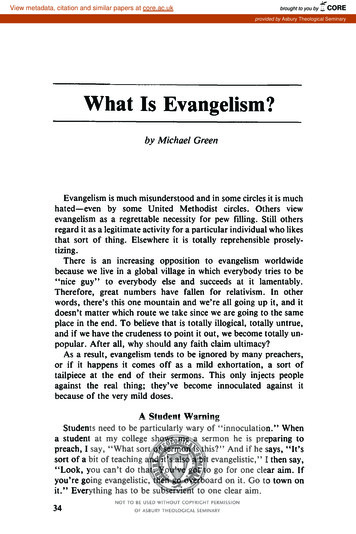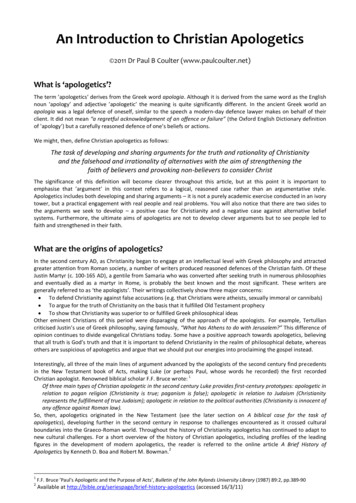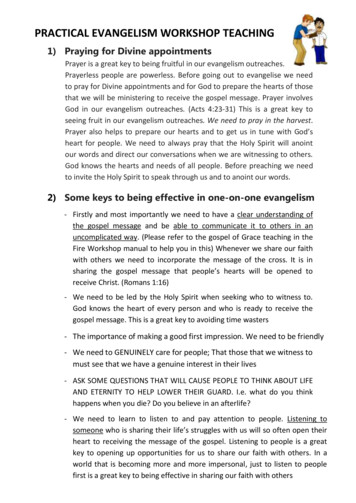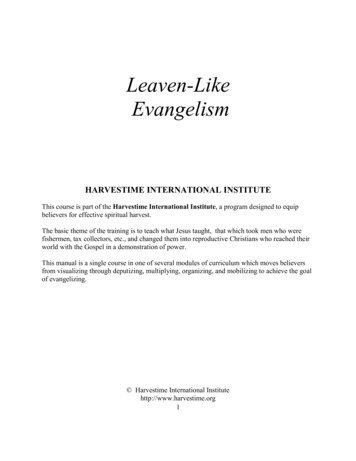
Transcription
Leaven-LikeEvangelismHARVESTIME INTERNATIONAL INSTITUTEThis course is part of the Harvestime International Institute, a program designed to equipbelievers for effective spiritual harvest.The basic theme of the training is to teach what Jesus taught, that which took men who werefishermen, tax collectors, etc., and changed them into reproductive Christians who reached theirworld with the Gospel in a demonstration of power.This manual is a single course in one of several modules of curriculum which moves believersfrom visualizing through deputizing, multiplying, organizing, and mobilizing to achieve the goalof evangelizing. Harvestime International Institutehttp://www.harvestime.org1
2
TABLE OF CONTENTSHow To Use This Manual.Suggestions For Group Study .Introduction .Course 49156PART ONE: GOIntroduction To Part One .1.2.3.4.5.6.7.8.9.10.11.12.13.14.15.Leaven-Like Evangelism.The Mandate .The Message .The Messengers.Communicating The Message.Recipients Of The Message .The Methods: New Testament PrinciplesThe Methods: New Testament ParablesThe Methods: Personal Evangelism .The Methods: Dealing With DifficultiesThe Methods: Saturation EvangelismThe Methods: Mass Evangelism.Decisions Or Disciples?.Planning For Evangelism.Networking For Evangelism .PART TWO: AS YOU GOIntroduction To Part Two. .16.17.18.19.167An Introduction To Healing And DeliveranceVariables That Affect Healing."As You Go, Heal" ."As You Go, Deliver" .1681962182343
PART THREE: WHILE YOU ARE THEREIntroduction To Part Three .20.21.22.271Church Planting: The Model .Church Planting: The Methods.Church Planting: The Multiplication .273280297APPENDIX: A Final Word .306Answers To Self-Tests.309.4
HOW TO USE THIS MANUALMANUAL FORMATEach lesson consists of:Objectives: These are the goals you should achieve by studying the chapter. Read them beforestarting the lesson.Key Verse: This verse emphasizes the main concept of the chapter. Memorize it.Chapter Content: Study each section. Use your Bible to look up any references not printed inthe manual.Self-Test: Take this test after you finish studying the chapter. Try to answer the questionswithout using your Bible or this manual. When you have concluded the Self-Test, check youranswers in the answer section provided at the end of the book.For Further Study: This section will help you continue your study of the Word of God,improve your study skills, and apply what you have learned to your life and ministry.Final Examination: If you are enrolled in this course for credit, you received a finalexamination along with this course. Upon conclusion of this course, you should complete thisexamination and return it for grading as instructed.ADDITIONAL MATERIALS NEEDEDYou will need a King James version of the Bible.5
SUGGESTIONS FOR GROUP STUDYFIRST MEETINGOpening: Open with prayer and introductions. Get acquainted and register the students.Establish Group Procedures: Determine who will lead the meetings, the time, place, and datesfor the sessions.Praise And Worship: Invite the presence of the Holy Spirit into your training session.Distribute Manuals To Students: Introduce the manual title, format, and course objectivesprovided in the first few pages of the manual.Make The First Assignment: Students will read the chapters assigned and take the Self-Testsprior to the next meeting. The number of chapters you cover per meeting will depend on chapterlength, content, and the abilities of your group.SECOND AND FOLLOWING MEETINGSOpening: Pray. Welcome and register any new students and give them a manual. Takeattendance. Have a time of praise and worship.Review: Present a brief summary of what you studied at the last meeting.Lesson: Discuss each section of the chapter using the HEADINGS IN CAPITAL BOLDFACED LETTERS as a teaching outline. Ask students for questions or comments on what theyhave studied. Apply the lesson to the lives and ministries of your students.Self-Test: Review the Self-Tests students have completed. (Note: If you do not want thestudents to have access to the answers to the Self-Tests, you may remove the answer pages fromthe back of each manual.)For Further Study: You may do these projects on a group or individual basis.Final Examination: If your group is enrolled in this course for credit, you received a finalexamination with this course. Reproduce a copy for each student and administer the exam uponconclusion of this course.6
MODULE:COURSE:EvangelizingLeaven-like EvangelismINTRODUCTION-Almost two-thirds of the world's population has never heard the Gospel message.-Over a thousand people groups have never been penetrated for the Lord JesusChrist.-Many tribes have never received their first missionary.-There are approximately 1,700 languages without the written Word of God.-The world's population will double in less than 50 years.When we think of statistics like these in terms of fulfilling the Great Commission of Jesus Christto take the Gospel of the Kingdom of God to every creature, we realize we are faced with a greattask. This course is written to mobilize and equip believers to fulfill this great challenge. It is atremendous task, but it is not impossible.Most courses on evangelism focus only on the command to "go" into all the world with theGospel. They emphasize preaching and teaching the Gospel message. This course differs becauseit also focuses on what Jesus said to do "as you go" and the New Testament Church pattern ofwhat to do "while you are there." The course is divided into three sections:Part One is entitled "Go." It focuses on the mandate given by Jesus to preach the Gospel of theKingdom of God to all creatures. It includes instruction on the message to be shared, themessengers, how to communicate the Gospel, and the recipients of the message. Methods ofevangelism are also taught, with emphasis on those used in New Testament times. Both personaland mass evangelism methods are discussed, with specific instruction on how to deal withdifficulties and the follow-up care of new converts. Instruction also is given on planning andmobilizing spiritual resources and networking with others for evangelism.Part Two is entitled "As you go." In the New Testament Gospels, Jesus never commissionedanyone to preach the Gospel without also commanding them to minister healing and deliverance.He told them "As you go.heal the sick, cast out demons . . ." (Matthew 10:1,7-8). As themultitudes came for healing and deliverance, the spiritual harvest began to multiply so rapidlythat new laborers were required. It was not long until 70 more disciples were needed and were7
sent out to preach, teach, heal, and deliver. It was this demonstration of power "as they went"that resulted in the rapid spread of the Gospel throughout the world. For this reason, Part Two ofthis course focuses on the healing and deliverance ministry that is to accompany the preachingand teaching of the Gospel.Part Three focuses on the pattern revealed by the New Testament Church of what to do "whileyou are there." It proposes that evangelism is not complete unless a church is planted among agroup of new believers. Evangelism without establishing local churches is like bringing childreninto the world and not claiming responsibility for their subsequent care. A person should not beconsidered "evangelized" until he becomes a functioning part of a local church fellowship. Toaccomplish this, there must be a local church. An area should not be considered evangelized untila church is planted.This three-part approach to evangelism is called "leaven-like evangelism" because it will spreadthe Gospel throughout the world rapidly even as leaven permeates a lump of bread dough. Theleaven may be small and hidden, but its impact is unlimited.8
COURSE OBJECTIVESUpon completion of this course you will be able to: Define leaven-like evangelism.Explain the mandate of evangelism.Summarize the message of evangelism.Identify the messengers of evangelism.Identify the recipients of the message.Communicate the Gospel to others.Summarize New Testament principles of evangelism.Summarize New Testament parables of evangelism.Do personal evangelism.Deal with difficulties you encounter in evangelism.Reach an entire area by saturation evangelism.Conduct mass evangelism.Follow up new converts.Make plans for evangelism.Network with others for evangelism.Summarize what the Bible teaches about healing and deliverance.Explain variables that affect healing."As you go, heal.""As you go, deliver."Describe the New Testament model for church planting.Follow New Testament methods to plant churches.Follow New Testament methods to multiply churches.9
INTRODUCTION TO PART ONE"GO"Part One focuses on the command to "go" into all the world and evangelize every living creature.In this section you will learn about the mandate given by Jesus to preach the Gospel of theKingdom and receive instruction on the message to be shared, the messengers of the Gospel,how to communicate the Gospel, and to whom it is to be communicated.You will learn many methods of evangelism, with emphasis on those used in New Testamenttimes. Both personal and mass evangelism methods are discussed, with specific instruction onhow to deal with difficulties in evangelizing and the follow-up care of new converts.Instruction is also given on planning and networking with others for the purpose of evangelism.And now . . . are you ready to "GO"?10
CHAPTER ONELEAVEN-LIKE EVANGELISMOBJECTIVES:Upon completion of this chapter you will be able to: Write the Key Verses from memory. Define "leaven-like evangelism." Explain "the definition of the lost." Explain "the destiny of the lost." Identify six steps in the evangelism process.KEY VERSES:And again He said, Whereunto shall I liken the Kingdom of God?It is like leaven, which a woman took and hid in three measures of meal, tillthe whole was leavened. (Luke 13:20-21)INTRODUCTIONThis lesson discusses the need for evangelism, explains the process of evangelism, and definesterms that are important for you to understand as you begin your study of this subject. In OldTestament times when the temple was built, the sound of a hammer, axe, or any tool of iron wasnot heard while it was being constructed (1 Kings 6:7).The silence with which those great natural stones were put into place is a natural example of agreat spiritual truth. A "greater than Solomon" is now building a greater spiritual temple. Thisspiritual temple is made up of "living stones" being laid by the Lord Jesus Christ. This templealso is being erected silently, with each stone perfectly fitted together. It is occurring through thesilent but powerful process of "leaven-like evangelism."LEAVEN-LIKE EVANGELISMAnd again He said, Whereunto shall I liken the Kingdom of God?It is like leaven, which a woman took and hid in three measures of meal, tillthe whole was leavened. (Luke 13:20-21)11
This passage reveals that God's work does not proceed with a lot of clamor and publicity. Youmight expect the Kingdom to spread by external means like subduing armies and conqueringcontinents. But the spreading of the Kingdom of God is as leaven in a lump of bread dough. Theleaven may be small and hidden, but it has unlimited potential. Like leaven, the power of theKingdom is not external but rather internal.In another example, Jesus compared the spread of the Kingdom of God to a mustard seed:. . . Unto what is the Kingdom of God like? and whereunto shall I resembleit?It is like a grain of mustard seed, which a man took, and cast into his garden,and it grew and waxed a great tree; and the fowls of the air lodged in thebranches of it. (Luke 13:18-19)In a previous parable, Jesus compared faith to a mustard seed. He said nothing was impossiblewith even a small amount of faith. Similar to the way leaven spreads, a tiny mustard seeddevelops into a great tree. This example also illustrates the silent, yet powerfully effective waythe Kingdom advances.There are many new methods that can assist in spreading the Gospel. These are called"technology." They include things such as printing presses, computers, radios, televisions, audioand video tapes, and satellites. New methods of transportation also help people travel rapidly tospread the Gospel. These new technologies are all useful but the real power of the Gospel is stillinternal. By this we mean the power is in the Gospel itself. This is what the parables of theleaven and the mustard seed illustrate.The Gospel of the Kingdom of God will multiply to spread throughout the whole "lump" of theworld because of the internal power of the Kingdom which is like leaven in bread dough. Thismeans that the extension of the Gospel is not limited where people do not have advancedtechnology. With even a small amount of faith, the Kingdom will advance. This is leaven-likeevangelism.THE DEFINITION OF EVANGELISMThe word for "evangelism" (or "evangelization") comes from a Greek word "evangelion." Thereare actually four forms of this basic word. One word means "good news," two words mean "toproclaim the good news," and one refers to the "evangelist" or person doing the proclaiming.Evangelism is not just a series of meetings or church services. Evangelism is not the same asrevival. Revival is the Lord at work in the Church. In revival, the emphasis is on the presence ofthe Lord restoring life to His people.12
Evangelism is the church at work for the Lord. In evangelism the emphasis is on the new birthexperience, the beginning of spiritual life. The renewal resulting from revival, however, sets inmotion the forces of evangelism which result in "new creatures in Christ" so the two are tightlylinked together in terms of spiritual life.Evangelism is:. . . "communicating the Gospel through the power of the Holy Spirit in such away that men and women have valid opportunity to accept Jesus Christ as Saviorand Lord and become responsible members of His Church."Let us examine this definition in detail. The "Gospel" is the message to be communicated. Thebasic Gospel message is summarized in 1 Corinthians 15:1-5, but the "Gospel of the Kingdom"actually includes all that Jesus taught (Matthew 28:18-20). Biblical conversion is brought aboutby truth. The Gospel is an encounter between truth and unrighteousness, Christ and sinners, andHeaven and Hell.It is the Gospel of the Kingdom of God which is to be shared, not the traditions of man ordenominational beliefs. The goal is not to attack political systems or other religions. The goal isnot to change society, but to see people changed through the power of the Gospel.The goal is not even the "good works" of educational, medical, or care and feeding programs.These things are beneficial in fulfilling the Great Commission only as they are done within thecontext of evangelism. The presentation of the Gospel must be the end goal or they become onlysocial programs.Jesus ministered to the physical needs of people in the feeding of the multitudes, healing, anddeliverance. But these works were done within the context of evangelizing. They wereaccompanied by the teaching and preaching of the Gospel.To "communicate the Gospel” means that it must be shared in a way that leads people to acceptJesus Christ as Savior and Lord. When you share the Gospel in this way, you are evangelizing.If you are to evangelize, you must be in contact with those who are spiritually lost in sin, soevangelism must take place out where the sinners are."Through the power of the Holy Spirit" means that the message must be communicated not onlyverbally, but through the demonstration of power. Paul said:And my speech and my preaching was not with enticing words of man'swisdom, but in demonstration of the Spirit and of power;13
That your faith should not stand in the wisdom of men, but in the power ofGod. (1 Corinthians 2:4-5)"Through the power of the Holy Spirit" also means that the anointing of the Holy Spirit must beupon the communication of the Gospel, for it takes the work of the Spirit to win converts:No man can come to me, except the Father which hath sent me draw him.(John 6:44)"Accepting" means that the hearer responds to the message. Information without invitation isinstruction. It is exhortation, but it is not evangelism. In true evangelism, there must be anopportunity for response. Giving someone your testimony of conversion is a method ofevangelism called witnessing, but it is not evangelism. Witnessing is not winning. Witnessing isimportant, but it does not assure salvation. True evangelism means introducing people to Christin such a way that they will see the necessity of a personal decision. Evangelism results in theborn again experience which is also called "conversion" or "salvation.""Accepting Jesus Christ as Savior and Lord" means not only a response to receive salvation, buta process which leads to Jesus becoming Lord of a person's life. This implies that the newconvert moves on into discipleship becoming a responsible member of the Church. Note that itis "His Church," meaning the true Body of Christ, not just a specific denomination ororganization.A "valid opportunity" means the message must be sustained long enough in a way that can beunderstood by an average person. This means communication must be adapted to the language,educational, and cultural levels of an individual. This also means that we cannot conclude that aperson or village has been evangelized simply because we preached there one time. The witnessmust be sustained long enough that understanding and opportunity for response results.Individuals, a family, tribe, or nation can be said to have been evangelized when they have comeinto contact with the Gospel enough to have had opportunity to respond to it by faith. This"valid opportunity" also implies a powerful message which provides opportunity for people tosee the visible demonstration of the Gospel through healing and deliverance.THE NEED FOR EVANGELISMWhy does the world need to be evangelized? To answer this question you must understand twothings: The definition and the destiny of the lost.DEFINITION OF THE LOST:Read about the creation of the world and man in Genesis chapters l and 2. Then read Genesis 3about how sin entered the world. When Adam and Eve were first created, they had a perfect14
sinless nature. After they sinned that nature was corrupted. As Adam and Eve began toreproduce and have children, these new additions to the human race were born with a basic sinnature. Man was no longer good as God had created him. His natural thought and action patternswere evil.Genesis 4:1-6:4 describes the pattern of sin as it began to spread throughout the world. Thesechapters record the first murder, the first lie, and how the wickedness of man grew until everythought, as well as action, was evil. Finally, the whole world was so sinful that God actuallyrepented that He had made man (Genesis 6:5-6).Because of the rapid growth of sin, God decided to destroy the earth with a flood but saved onerighteous man, Noah, and his family. (Read the story of Noah and the flood in Genesis 6:89:17.) After the flood, Noah's family began to reproduce. Almost immediately, the pattern of sinreoccurred. This is why all people everywhere are called "sinners":For all have sinned, and come short of the glory of God. (Romans 3:23)All people who have not repented of sin and experienced the new birth described by Jesus inJohn chapter 3 are considered "lost" because they have lost the sinless nature with which Godoriginally created man. We may also say they are "unsaved" or "unbelievers" because they havenot been saved from their sins through believing in the Lord Jesus Christ as Savior.DESTINY OF THE LOST:Because of the original sin of Adam and Eve, death entered into the world and because of thiseventually everyone dies physically. After physical death comes judgment:And as it is appointed unto men once to die, but after this the judgment.(Hebrews 9:27)After death, we will stand before God for judgment. People who have not repented of their sinswill face a second death. They will die the "spiritual death" of eternal separation from God.Their destiny is Hell:For the wages of sin is death; but the gift of God is eternal life through JesusChrist our Lord. (Romans 6:23)And I saw the dead, small and great, stand before God; and the books wereopened; and another book was opened, which is the book of life: and thedead were judged out of those things which were written in the books,according to their works. . .15
And whosoever was not found written in the book of life was cast into thelake of fire. (Revelation 20:12, 15)When you really understand the destiny of the lost, you realize the urgent need for evangelism.If people are not reached with the Gospel, they will die in sin and be destined for eternity in Hell.THE PROCESS OF EVANGELISMEvangelism is a process that includes the presence and proclamation of the Gospel, persuasion,planting, perfection, and participation. Let us examine this process:PRESENCE:"Presence" evangelism is that which radiates the qualities of Jesus through demonstratingChristian character and concern. The world will not be reached for Jesus without an authenticChristian presence. Believers must learn to build relationships, identify with, and serveunbelievers. You cannot win sinners if you have no contact with them.PROCLAMATION:Many believers remain "secret-service" Christians, so to speak. They think their presence amongunbelievers is enough to fulfill the Great Commission to evangelize the world. But the commandof Jesus is that we verbally communicate the Gospel through preaching, teaching, andwitnessing. We must also demonstrate the power of the Gospel through healing and deliverance.These are ways the Gospel is proclaimed.PERSUASION:Proclamation of the Gospel does not end the process of evangelism. The Gospel must bepresented in such a way that people are persuaded to become believers in Jesus Christ.PLANTING:The new convert who has been persuaded to follow Jesus must then be "planted" in a localchurch fellowship or a church must be "planted" among a group of new believers.PERFECTION:As a result of this planting, converts mature spiritually as discipling is accomplished within thecontext of the local church. (Spiritual maturity is called "perfection" in the Bible).16
PARTICIPATION:The process of evangelism is complete when new believers become active in the task ofevangelism themselves and begin to reproduce spiritually.17
SELF-TEST1.Write the Key Verses from memory.2.Define "leaven-like evangelism."3.What is meant by "the definition of the lost"?4.What is meant by "the destiny of the lost"?5.List six steps in the evangelism process.(Answers tests are provided at the conclusion of the final chapter in this manual.)18
FOR FURTHER STUDY1.In this introductory chapter you were introduced to the definition of "evangelism":Evangelism: Evangelism is communicating the Gospel through the power of theHoly Spirit in such a way that men and women have valid opportunity to acceptJesus Christ as Savior and Lord and become responsible members of His Church.Here are some other terms with which you should be familiar:Evangelize Or Evangelizing:These terms are used for the process of doing the work of evangelism.Evangelized:Individuals, a family, tribe, or nation can be said to have been evangelized when they have comeinto contact with the Gospel long enough to have had an opportunity to respond to it by faith.The completed process of evangelization includes integrating a convert into a local churchfellowship or the planting of a church among a group of new believers.Evangelist:An evangelist has a special leadership gift from God which is an ability to share the Gospel withunbelievers in a way that men and women respond and become responsible members of the bodyof Christ. The meaning of the word "evangelist" is "one who brings good news." Although allbelievers do not have the special leadership gift of being an evangelist, all are to do the work ofan evangelist.Witnessing:A believer telling an unsaved person about his personal experience with Jesus Christ.Personal Evangelism:Personal evangelism is an individual believer communicating the Gospel to an unsaved person.Mass Evangelism:Mass evangelism is also called "group" evangelism. It is communicating the Gospel to a groupof people. It includes such activities as mass crusades, evangelistic rallies, and Gospel concerts.19
Lay Evangelism:This term refers to any evangelistic work done by laymen (people who are not in full-timeleadership positions in the church).Saturation Evangelism:Saturation evangelism refers to "saturating" a certain geographic area so every person is reachedwith the Gospel.Convert:A convert is a person who has accepted Jesus Christ as Savior. He has been converted from hisold life of sin to new life in Jesus.Disciple:A disciple is a convert who is established in the basics of the Christian faith and capable ofraising up new converts and discipling them. The word "disciple" means a learner, a pupil,someone who learns by following.Follow Up:Follow up is the process of training new converts and bringing them to maturity in Christ,resulting in spiritual stability, growth, and reproduction. This is also called "discipleship"because it involves taking a new convert and making him a disciple of the Lord Jesus Christ.2.In Old Testament times, God told Abraham that through him all the nations of the worldwould be blessed. But with this blessing came a great responsibility. Abraham had toleave his country, his own people, and his father's household to go to a land God wouldshow him (Genesis 12:1).Abraham first went to a place called Haran and settled there (Genesis 11:31). He was tempted tostay at Haran, but to receive the blessing he had to obey God and leave this place. Abrahamcould not become the father of a great nation and fulfill his own selfish ambitions at the sametime. Crossing the city limits of Haran and moving on to fulfill God's plan was a great decisionfor Abraham.Did you know that you are a believer today because of Abraham's decision? Because Abrahamleft Haran, God blessed him. Through Abraham, all men and women of all nations everywhereare blessed with the Gospel. They are blessed because salvation through Jesus Christ came fromthe family of Abraham because of his obedience.20
Like Abraham, when you receive the blessing you also receive a great responsibility. To thosewho have been blessed with salvation and the Holy Spirit, evangelism is not an option. It is anobligation (Acts 1:8).Spiritually speaking, every believer eventually faces a "Haran" in his life. This spiritual "Haran"is the place where God asks, "Are you willing to lay down your own ambitions for the sake ofthe Gospel? Are you willing to leave your homeland, your people, your father's house should Iask it"? You cannot fulfill your own selfish ambitions and bless the nations at the same time.You must cross the line and leave Haran behind.3.The Bible says "A little leaven leaveneth the whole lump" (Galatians 5:9). You learnedin this lesson that the Kingdom of God will multiply like leaven. Evil also multiplies inthe same way. Study the following verses: Matthew 16:6-12; Mark 8:15; 1 Corinthians5:6-8. In the New Testament, leaven can speak of the permeating quality of the Gospelor the apostasy (backslidden condition) of the Church. In the Old Testament, leavenapparently had similar meanings. It was not permitted in some offerings, as itsymbolized evil. In other offerings, such as the thank offering, it was permitted.4.If you are a pastor or leader in the local church, use the following questions to evaluatethe current status of evangelism in your fellowship. Record your answers on a separatesheet of paper:(1) Who is responsible for planning for evangelism in your church?(2) How many persons were converted and became part of your church fellowship in the lastfive years?(3) What does your church presently do to reach the unsaved? Be specific in your answer.(4) What programs do your church presently have that are not effective in terms of evangelismand producing new converts?(5) How does your church help members discover their spiritual gifts and use them in the task ofevangelism?(6) What plan does your church have for reaching your community with the Gospel?(7) What plan does your church have for reaching your nation with the Gospel?(8) What plan does your church have for reaching other nations with the Gospel?(9) How often in the past five years has your church provided specific training for personalevangelism for your membership?21
(10) How often do your services include a focus on evangelism, i.e., messages aimed at reachingthe unsaved, providing people opportunity to respond to the Gospel, etc.(11) When was the last time your church participated in mass evangelism efforts, such as acrusade, rally, or concert, etc.?Evaluate your answers and consider the following:(1) If you do not have a specific person responsible for planning for evangelism in your church,is it possible to appoint someone?(2) If the number of people who were converted and became part of your church fellowship inthe last five years is low, how could this be changed by a greater emphasis on evangelism?(3) What could your church begin to do immediately to reach the unsaved?(4) What ineffective programs do you presently have that could be eliminated to provideopportunity for new, more evangelistic efforts?(5) How could your church help members discover their spiritual gifts and use them in the taskof evangelism? (The Harvestime International Institute course "Mobilization Meth
evangelism are also taught, with emphasis on those used in New Testament times. Both personal and mass evangelism methods are discussed, with specific instruction on how to deal with difficulties and the follow-up care o
